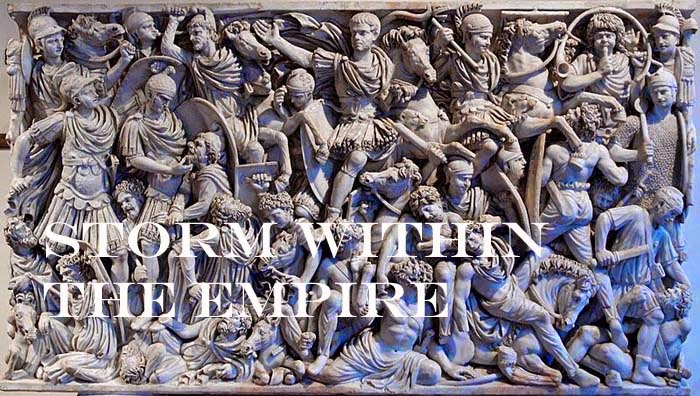The Early German army lists spas a long period of time
confronting four different periods of Rome. During the late 2nd early
3rd century we read more of more barbarian tribes taking advantage
of Roman civil strife to invade the Empire. The following three
battles actually take place in terrain familiar to the Early German, forest.
II/64b Middle
Imperial Roman (Western)
1 x general (Cv), 1 x cavalry (Cv), 1 x horse archer
(LH), 4 x legionnaires (4Bd), 3 x auxiliary (4Ax), 1 x archers (4Bw), 1 x Cataphract (3Kn).
II/47g
Early German
1 x general (Cv), 2 x cavalry (Cv), 8 x warriors
(4Wb), 1 x javelinmen (Ps).
Game one
The Roman infantry deployment equaled that of the
entire German position; however, their formations were noticeably deeper and
could prove troublesome. The field between the two armies was devoid of any
hindering obstacles and as a precautionary measure auxilia were placed in the
wood.
Taking advantage of the slow advance by the Germans, the Roman infantry line wheeled to the left forcing the enemy to funnel their attack, but first the wood would have to be cleared of German skirmishers.
Battle lines now met and the barbarians confined in
their deep formations were getting the worst of the situation. Roman cavalry reserve
was moved forward to support any breakthrough made by the legionnaires.
The barbarian numbers now pressed their advantage as
they slew half the legionary troops. Hearing the cry of victory on the right,
the commander could not notice German cavalry has successfully broken out of
their predicament and would be moving to the Roman rear. The signal was given
to retreat, score 4 – 3 for the Early
Germans.
Game two
From the Roman position one could noticeably see the
German line nearly matched that of the deployed legion and auxilia units. The German
cavalry were dispersed to both flanks and noteworthy there were fewer columns of
infantry.
The barbarians struck first to send a shock wave
through the Roman line quickly destroying a large part of it leaving frenzied
Germans facing the Roman general.
After losing another Roman unit the call for retreat
was ordered leaving twice as many Roman dead as barbarians, score 4 – 2 for the Early Germans.
Game
three
Grouping all her cavalry on the left flank, the
barbarian line appeared just as long as that of Rome.
Forming two divisions, the left hand division would
engage the Roman cavalry while all the German infantry would attack the legions
as they climbed up the hill. This was successfully done catching the Roman line
in disarray.
Rushing downhill the Germans breached the Roman line
in a number of places; the German cavalry could add more casualties to bring
the final score to 4 – 1 for the Early
Germans.











Three interesting battle reports, thanks. Do you think the Romans would have more success with a reserve to catch the Wb when it is potentially double-overlapped?
ReplyDeleteHesperiana,
ReplyDeleteI caught your comment rather late, but to answer your question, yes, it is a sound tactic keeping elements in reserve.
Cavalry are ideal for this as they move 4 base widths and warband are disadvantaged by mounted; they do not count rear support and combat factor is lower.
Foot troops cannot react as quickly so most players will place them too far forward which risks their being held up by enemy threat zones.